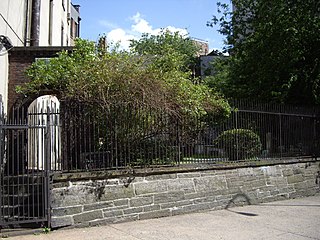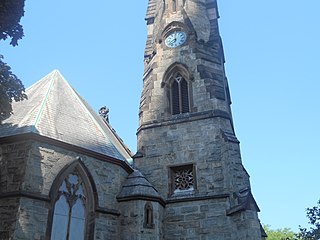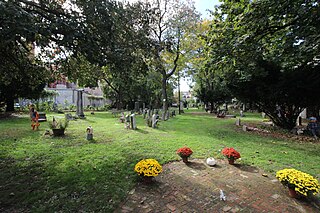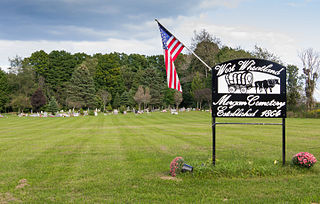
A cemetery, burial ground, gravesite, graveyard, or a green space called a memorial park, is a place where the remains of many dead people are buried or otherwise interred. The word cemetery implies that the land is specifically designated as a burial ground and originally applied to the Roman catacombs. The term graveyard is often used interchangeably with cemetery, but a graveyard primarily refers to a burial ground within a churchyard.

Rossville is a neighborhood of Staten Island, New York, on the island's South Shore. It is located to the north of Woodrow, to the west of Arden Heights, and to the south and east of the Arthur Kill. Rossville is located within Staten Island Community Board 3.

Oakland Cemetery is one of the largest cemetery green spaces in Atlanta, Georgia, U.S. Founded as Atlanta Cemetery in 1850 on six acres (2.4 hectares) of land southeast of the city, it was renamed in 1872 to reflect the large number of oak and magnolia trees growing in the area. By that time, the city had grown and the cemetery had enlarged correspondingly to the current 48 acres (190,000 m2). Since then, Atlanta has continued to expand so that the cemetery is now located in the center of the city. Oakland is an excellent example of a Victorian-style cemetery, and reflects the "garden cemetery" movement started and exemplified by Mount Auburn Cemetery in Massachusetts.

An unmarked grave is one that lacks a marker, headstone, or nameplate indicating that a body is buried there. However, in cultures that mark burial sites, the phrase unmarked grave has taken on a metaphorical meaning.

God's Acre is a churchyard, specifically the burial ground. The word comes from the German word Gottesacker, an ancient designation for a burial ground. The use of "Acre" is related to, but not derived from the unit of measurement and can be of any size. In the early 17th century the term was used as a translation of the German, but by the end of the century, it was accepted as an English term.

Mount Moriah Cemetery on Mount Moriah in Deadwood, South Dakota, is the burial place of Wild Bill Hickok, Calamity Jane, Seth Bullock and other notable figures of the Wild West.

Byram is a neighborhood/section and census-designated place (CDP) in the town of Greenwich in Fairfield County, Connecticut, United States. It had a population of 4,146 at the 2010 census, and a census-estimated population of 4,216 in 2018. An endcap of Connecticut's Gold Coast, Byram is the southernmost point in the town of Greenwich and the U.S. state of Connecticut. It is separated from Port Chester, Westchester County, New York, by the Byram River. Byram was once known as East Port Chester.

First Shearith Israel Graveyard, also known as Chatham Square Cemetery, is a tiny Jewish graveyard at 55-57 St. James Place in the Two Bridges neighborhood of Lower Manhattan, New York City. It is the oldest of three Manhattan graveyards currently maintained by Congregation Shearith Israel, which is itself the oldest Jewish congregation in North America. Today, the cemetery is a mere fragment of its original extent. Only about a hundred headstones and above ground tombs can still be seen in what remains of the old burial ground, which rises slightly above street level. It is the only remaining 17th century structure in Manhattan.

Trinity-St. Paul's Episcopal Church in New Rochelle in Westchester County, New York was added to the National Register of Historic Places in 2006. It is located at the northwest corner of Huguenot Street and Division Street. This church represents the body of the majority group of New Rochelle's founding Huguenot French Calvinistic congregation that conformed to the liturgy of the established Church of England in June 1709. King George III gave Trinity its first charter in 1762. After the American Revolutionary War, Trinity became a parish of the Protestant Episcopal Church of America.

Oaklawn Cemetery is the first public burial ground in Tampa, Florida, United States. The location was deeded in the mid-19th century and was described as the final resting place for "White and Slave, Rich and Poor." Oaklawn Cemetery is located at the intersection of Morgan Street and Harrison Street in downtown Tampa, about two blocks South of I-275. It has approximately 1,700 graves.

The Myles Standish Burial Ground in Duxbury, Massachusetts is, according to the American Cemetery Association, the oldest maintained cemetery in the United States.

Old Bergen's Speer Cemetery is located at 145 Vroom St in the Bergen Square neighborhood of Jersey City, New Jersey, between Bergen Ave. and Van Reypen St.

Eden Cemetery is a historic African-American cemetery located in Collingdale, Pennsylvania. It was established June 20, 1902, and is the oldest existing black owned cemetery in the United States. The cemetery covers about 53 acres and contains approximately 93,000 burials.

Mount Zion African Methodist Episcopal Church and Mount Zion Cemetery is a historic church and cemetery located at 172 Garwin Road in Woolwich Township, New Jersey, United States. The church was a stop on the Greenwich Line of the Underground Railroad through South Jersey operated by Harriet Tubman for 10 years. The church provided supplies and shelter to runaway slaves on their way to Canada from the South. The church and cemetery were part of the early 19th-century free negro settlement sponsored by Quakers known as Small Gloucester.

Old St Mark's Anglican Church is a heritage-listed former church and current church hall at 2 Boronia Drive and 41A Winnetts Road, Daisy Hill, City of Logan, Queensland, Australia. It was built in 1901 by W Anthony. It was known as St Mark's Anglican Church. It was added to the Queensland Heritage Register on 30 March 2001.

The Morgan West Wheatland Cemetery is a cemetery located on 55th Avenue between 10 & 11 Mile Roads in Wheatland Township, Mecosta County, Michigan. It was listed on the National Register of Historic Places in 2014.

Point of Graves Burial Ground is a small historic cemetery in Portsmouth, New Hampshire, dating to the 17th century. It was the final resting place for many of Portsmouth's prominent residents including the Wentworth family, the Vaughan family, the Rogers, and the Lears. It is the oldest known surviving cemetery in Portsmouth, and one of the oldest in the state. It has about 125 gravestones. Previously neglected, it is now well maintained by the Mayor's Committee and the city. The cemetery plot was on a point of land that directly overlooked the Piscataqua River in earlier times.

Savannah Memorial Park Cemetery also known as El Monte Memorial Park and the Savannah Pioneer Cemetery is the oldest American non-sectarian cemetery in Southern California. The park is located in Rosemead, California, part of the park is in the neighboring city of El Monte. The park has been in continuous operation since its founding in 1850. Some of the burials may date back into the 1840s before Savannah Memorial Park became a Memorial Park. Savannah Memorial Park was designated a California Historical Landmark on March 6, 2012.

The Canadian Indian residential school system was a network of boarding schools for Indigenous children directed and funded by the Department of Indian Affairs. Administered by various Christian churches and funded by the Canadian government from 1828 to 1997 Canadian Indian residential school system attempted to assimilate Indigenous children into Euro-Canadian culture. Over 4,000 students died while attending Canadian residential school. Students' bodies were often buried in school cemeteries to keep costs as low as possible. Comparatively few cemeteries associated with residential schools are explicitly referenced in surviving documents, but the age and duration of the schools suggests that most had a cemetery associated with them. Many cemeteries were unregistered, and as such the locations of many burial sites and names of residential school children have been lost.

The desecration of graves involves intentional acts of vandalism, theft, or destruction in places where humans are interred, such as body snatching or grave robbing. It has long been considered taboo to desecrate or otherwise violate graves or grave markers of the deceased, and in modern times it has been prohibited by law. Desecration is defined as violating something that is sacred.





















